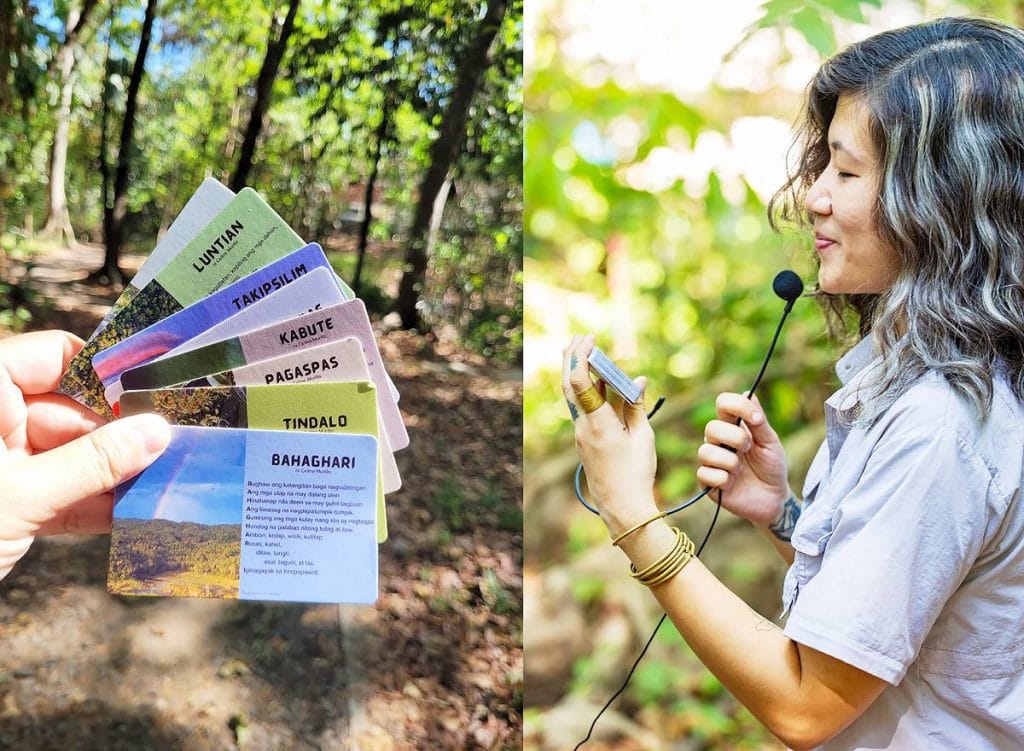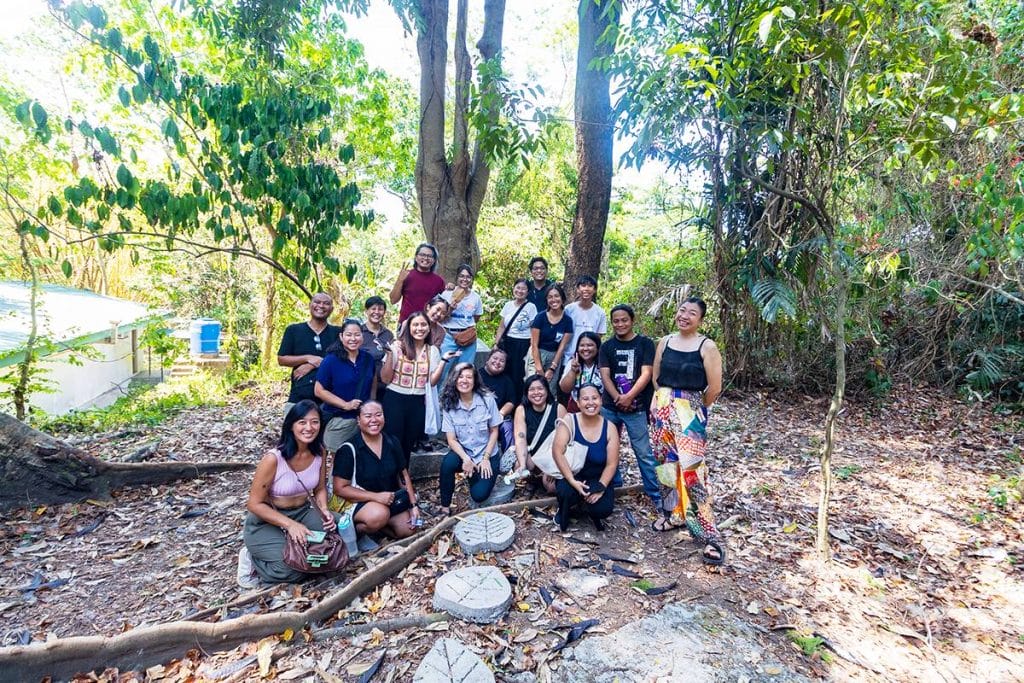There aren’t a lot of places in Metro Manila where city dwellers can walk under the shade of trees, breathe in fresh air, go birdwatching, or relax with views of nature. But if you take a closer look, you can find a few urban forests and eco-trails hidden behind traffic-choked streets and towering concrete buildings.
One quiet Sunday morning, I found myself transported to a mini-forest a five-minute drive from my house on a native tree appreciation walk. We all know that trees play a crucial role in lowering temperatures in cities and reducing air pollution, but we rarely take the time to appreciate them. During the guided tree walk, we were invited to touch and smell leaves, taste fruits plucked straight from the trees, and admire tree trunks up close while learning about their natural properties and uses.

While navigating the eco-trail, our group was treated to poetry readings by nature storyteller Celine Murillo, who uses social media platforms to promote and mainstream Philippine biodiversity. According to the environmentalist, who launched Likas-Wika, a collection of poetry, photo cards, and short films based on and inspired by nature in partnership with The Philippine Forest Foundation, tree walks can help people care more for nature.
“Native trees are part of our heritage, our Filipino identity. Knowing about it, being familiar with it, will eventually lead to understanding and caring for it. With this, we will be moved to see these trees as our fellows, more than something to exploit,” Murillo told The Philippine STAR.

“Even a walk in your own neighborhood will reveal patches of the Natural World – seedlings in the sidewalk, bushes through the pavement crack, and birds along electric wires. They’re waiting to be rediscovered, just open yourself up to the world’s awe and wonder,” said Murillo.
If you’re interested in seeing local flora and fauna for yourselves up close, here are a few places to go on nature walks amid the busy metro.
UP Diliman Campus
The UPIB-EDC BINHI Threatened Species Arboretum established by the UP Institute of Biology in the UP Diliman Campus in Quezon City is a one-hectare park that contains around 70 species of endangered indigenous trees. It also functions as a gene and seedling bank for threatened trees. Some of the native trees you can spot here include Dao, which has edible fruit and medicinal bark and flowers; Tangisang-bayawak, a large tree that bears figs; and Bagras, also called the “Rainbow Tree” because of its colorful bark. The arboretum also includes a fernery and a memorial to Leonard Co, the foremost Filipino plant taxonomist and ethnobiologist in the country.

Other spots for tree walks within the campus include the Marine Science Institute’s Garden of Indigenous and Flowering Trees and the Washington Sycip Garden of Native Trees, a short tree-lined path behind the UP Carillon and coming from the Academic Oval.
Access to the UP Diliman Campus is free and open to the public.
Ninoy Aquino Parks and Wildlife Center
The Ninoy Aquino Parks and Wildlife Center is an urban park and protected area in the middle of a highly urbanized environment in Quezon City that’s home to more than 3,000 individual trees, with at least 13 endemic species found such as Ipil, Kamagong, Narra, and Molave. The park also has a lagoon, an aquarium, a playground, a botanical garden and a Wildlife Rescue Center, being used by the DENR.
Access to NAPW is free for PWDs, Senior Citizens, and children below 7. The regular entrance fee is P30 for adults, P15 for students, and P100 for foreign tourists.
Arroceros Forest Park
Dubbed “Manila’s last lung,” Arroceros Forest Park is a riverside urban forest park located within a 2.2-hectare lot in Manila that’s home to about 3,000 trees, including native trees such as Bagras, Bignay Kalabaw, Dao, Talisay, and Yakal. Different bird species also use the park as their natural habitat and nesting ground. The park has been enjoying newfound popularity, as the temperature here was recently recorded to be 5°C cooler than the rest of the city.
Access to Arroceros Forest Park is free and open to the public.
Las Piñas-Parañaque Wetland Park
The Las Piñas-Parañaque Wetland Park, a protected area along Manila Bay right next to CAVITEX is a great place to spot migratory birds and appreciate the role of wetlands in our ecosystem. This area, dubbed “Metro Manila’s Last Coastal Frontier” hosts important bird habitats such as mangroves, beach forests, lagoons, and mudflats. Along with native mangrove species, the site has a short trail of other native trees including Agoho, Alagaw, Kamuning, and Nilad, where Manila gets its name.
Access to Las Piñas-Parañaque Wetland Park is free and open to the public for bird watching/ photography, eco-tour, scientific research, photoshoot/video shoot and coastal clean-ups, though visitors must secure a permit before their visit.

What type of trees should we plant in the Philippines?
Planning to join a tree-planting event? Environmentalists campaign against the planting of mahogany and other invasive species in the Philippines, because these trees are not good for the local ecosystem. They prevent native trees from growing and choke out local wildlife. In an educational video Forest Regeneration 101, Murillo recommends the following Philippine Native Trees (PNTs) as alternatives:
- Easy-to-grow PNTs like Bangkal and Igyo
- Bee-friendly PNTs like Rarang and Lagundi
- Bird-friendly PNTs like Malabulak
- Fire-resistant PNTs like Bagras
- PNTs for waterways like Dao
- Windbreaker PNTs like Malabago
* * *
While you can easily visit most of these sites on your own, guided walks can leave visitors with a better appreciation for native trees. Murillo recommends interested parties get in touch with the Philippine Native Tree Enthusiasts group on Facebook, as they host regular tree walks in Metro Manila.
Guided tours to UPIB-EDC BINHI Threatened Species Arboretum are subject to approval and availability. For educational tours, please send a formal letter of request to Ms. Melizar V. Duya (lizavduya091@gmail.com).
According to the Las Piñas – Parañaque Wetland Park-Protected Area Management Office (PAMO), requests to visit the Las Piñas-Parañaque Wetland Park must be made at least 2 weeks before their intended date due to requirements from the Philippine Reclamation Authority (PRA). Visitors permit requests can be sent via denrncrored@gmail.com and denrncrlppchea@gmail.com. The site has a maximum daily capacity of 230 persons.
